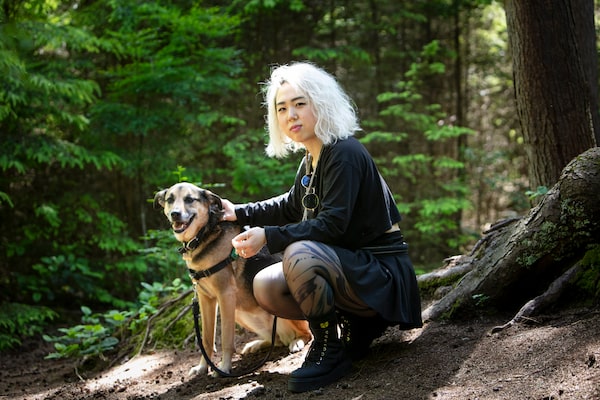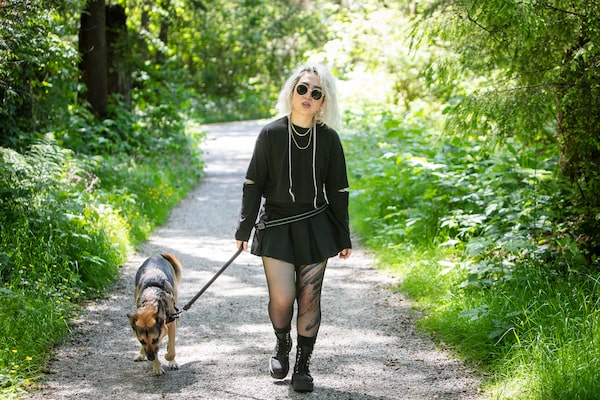
Joy Yoo, a Vancouver artist, spent lots of time during the pandemic with their dog. They found they were also spending too much money online shopping and adjusted their self-care routine to include more friends and community activities.Rafal Gerszak/THE GLOBE AND MAIL
Joy Yoo’s dog is a pretty good indicator of their mental health.
“I’ll project on [my dog, thinking] ‘Oh, she seems kind of sad, maybe she wants to go out,’ when it’s actually me that wants to go out,” they say. Their self-care routine prior to COVID-19 included snacks, naps and lots of time spent in nature.
When the pandemic hit, however, Yoo, an artist based in Vancouver who usually got stressed whenever they spent too much money, found themselves increasingly impulse-shopping online under the guise of self care. Learning how to do makeup for hooded eyes through TikTok videos, for example, led them to purchase more makeup.
Yoo isn’t alone in increasing their spending at the beginning of the pandemic. When the pandemic forced people inside, it led them to prioritize their comfort and well-being, redefining self care in the process. Many Canadians replaced their workwear with loungewear, eschewed makeup to invest in skin care, and purchased workout gear to make up for the activities lost to lockdown rules.
Ann Marie Elpa, a Toronto-based freelance journalist, also admits to buying a lot of unnecessary items, such as fast fashion, during the pandemic.
“It was a really bad coping mechanism of mine,” she says. “When I’d be sad, [I would shop]. I’d call this ‘depression shopping.’ "
She says her spending was partially fuelled by ads on social media, by pressure to maintain a certain image online and by a culture that recommends easing sadness by “treating yourself.”
Despite self care being a broad concept that includes being mindful of socioeconomic and environmental factors, self care is often reduced to self-indulgence by companies promoting conspicuous consumption. Elpa’s pre-pandemic self care, she says, consisted of “superficial” things like face masks, baths with candles and Epsom salts – and shopping.
“Most of my self care was taking care of my skin and body and I didn’t really think of taking care of my mind,” says Elpa. The pandemic forced her to change her self-care habits, especially after she was diagnosed with bipolar II disorder. Elpa now shops less and goes to therapy and the gym regularly. She also got a cat.
Tabassum Wyne had a similar experience. Before the pandemic, Wyne’s responsibilities as the executive director of the Muslim Advisory Council of Canada, and a mother of two, kept her busy.
“The pandemic really forced me to implement a self-care routine and that [included] exercising, going for walks, taking my kids to the park, journaling,” she says. “But also spiritual wellness. Making sure that I’m … praying five times a day, that was really important to me.”
The biggest change Kylie McMullan, principal of Finch Media, a public relations and marketing agency in Vancouver, made to her self-care routine during the pandemic was going to therapy as well as physiotherapy.
“These [are] two things that I felt like I needed for a long time, but I never found the time,” she explains.
McMullan says that the changes she made to her self care resulted in spending less money now, as she is more mindful of where and how she spends – especially given how costs have gone up.
“With the rising costs of living, and two kids and the expenses of living in a really expensive city, I would say I’m a little more conscious [of how I spend my money],” says McMullan. “In the past, I did whatever was the easiest, not necessarily what was most affordable, whereas now I … spend a little bit more time being like, ‘Do I really need this face cream? Do I really need this spray?’ "
The theme of being more intentional, both with one’s spending and actions, is a common one. Marianne El-Mikati, a master’s student at the University of British Columbia, says that a big change to her self-care routine included spending more time outside, getting more exercise and being more mindful of her actions.

Joy Yoo changed their self-care routine after the pandemic to be more mindful of their mental health instead of turning to online shopping.Rafal Gerszak/THE GLOBE AND MAIL
“Whether it was getting dressed or walking my dog or making food for my family, I started being a more intentional about it,” says El-Mikati. This was motivated in part by her faith, Islam, which she made a conscious effort to focus on during the pandemic.
El-Mikati adds that though she spends more money now, it is usually on fulfilling experiences – such as a pottery class with her friends – and hobbies like reading and painting. “Choosing to have these activities that can just be for the purpose of pure enjoyment, in the moment, was a big thing that I started doing.”
After pausing to reflect on their impulsive spending, Joy Yoo cultivated a similar mindfulness toward their self-care routine. “[I was] treating symptoms but not the cause of mental illness where I was needing a lot of self care,” they say.
As a result, Yoo intentionally altered their self-care habits to being more community-centred than self-centred. “Ultimately it is just a better hit to be around people, taking care of your community, being around people that need you, [and] being a good friend.”